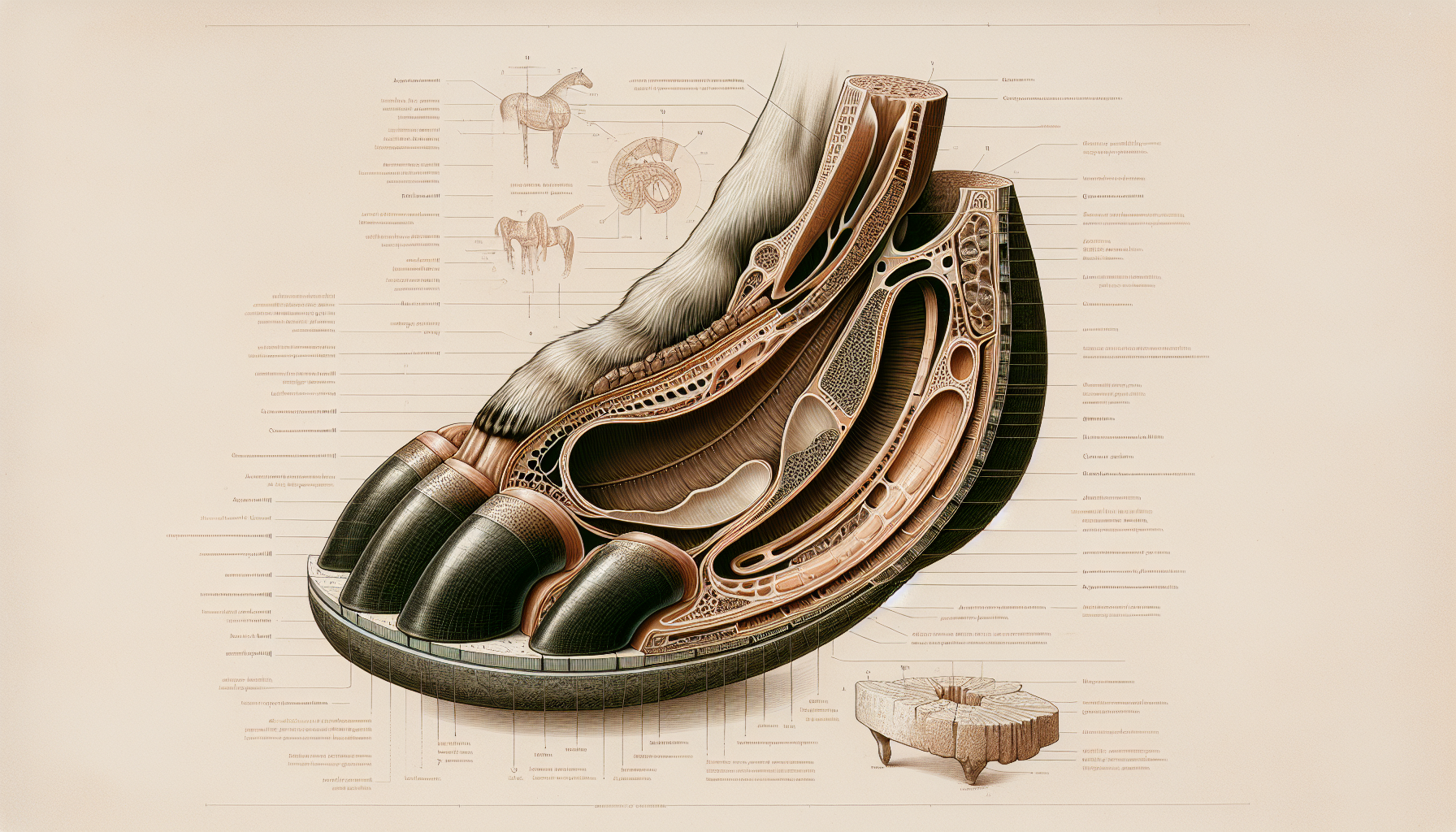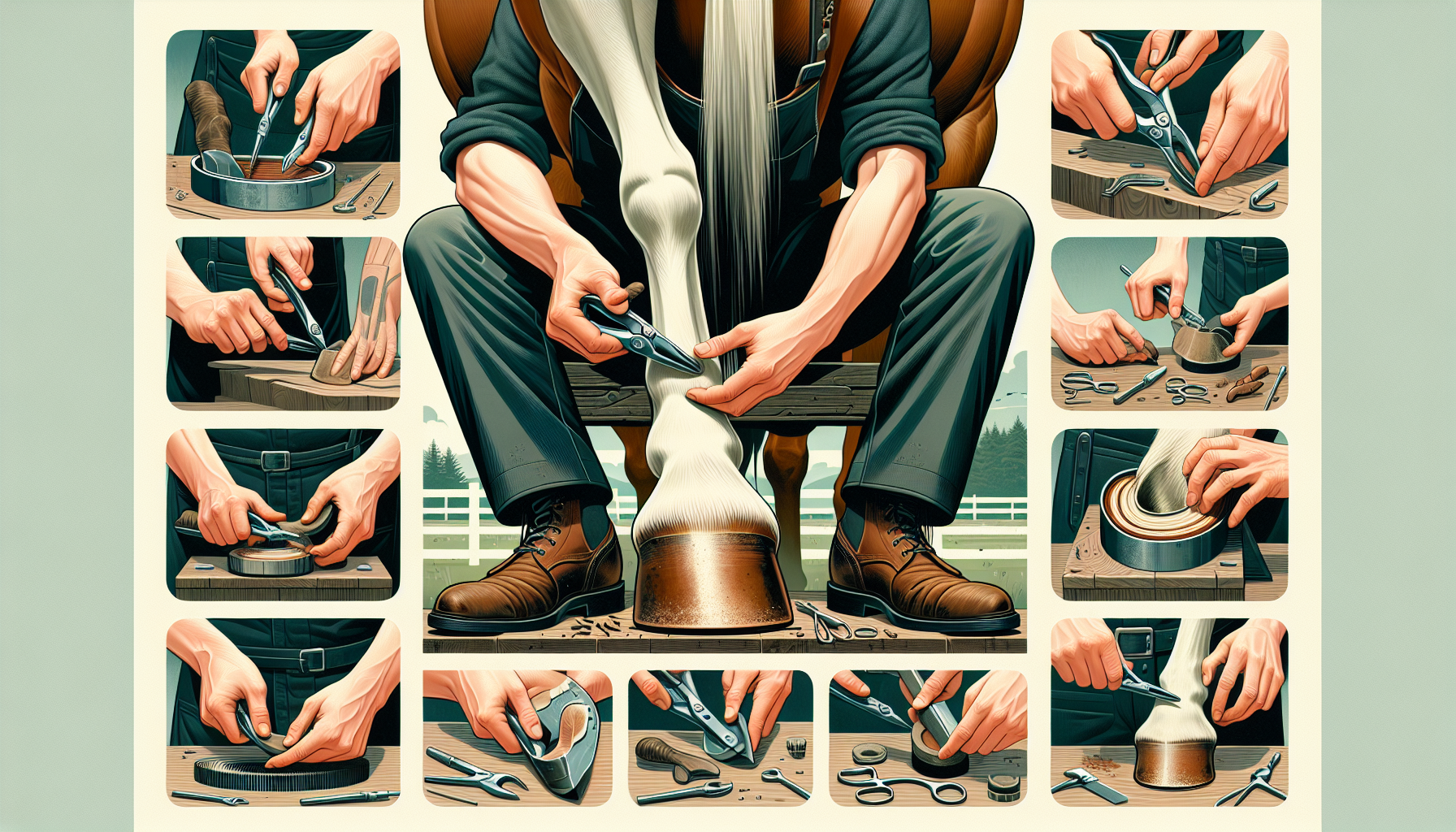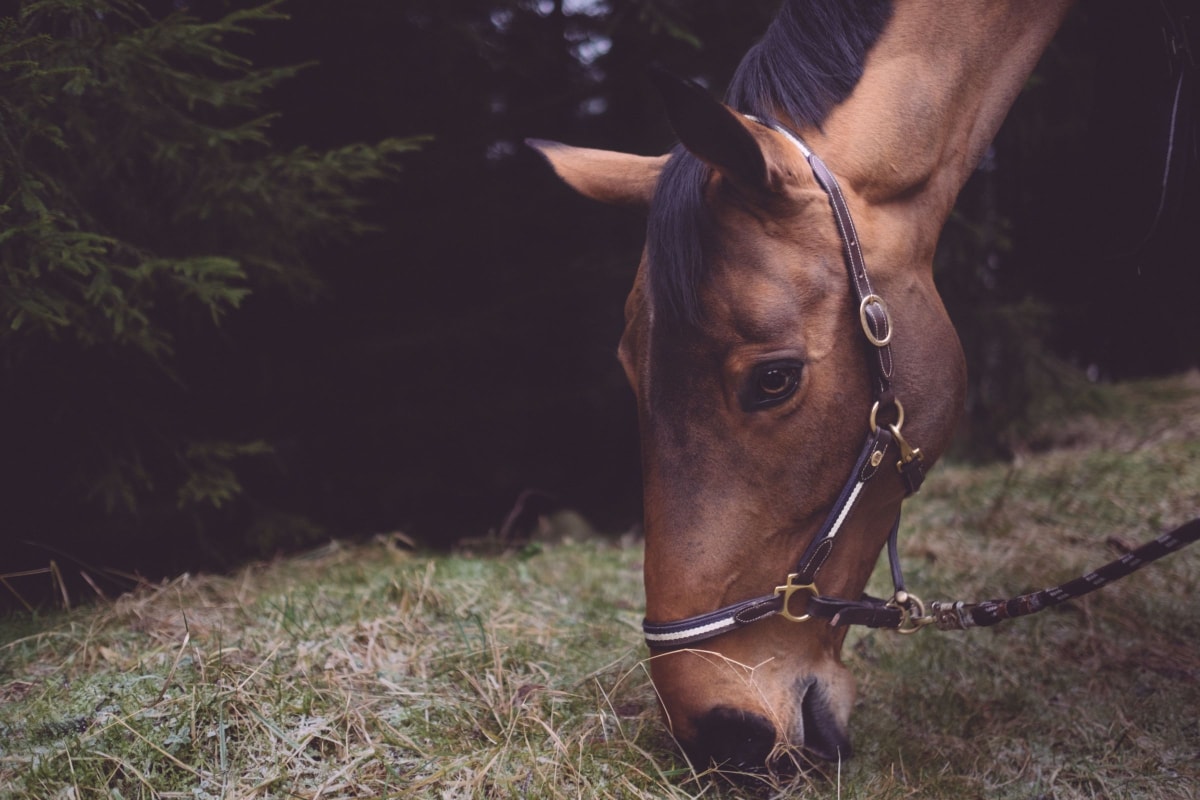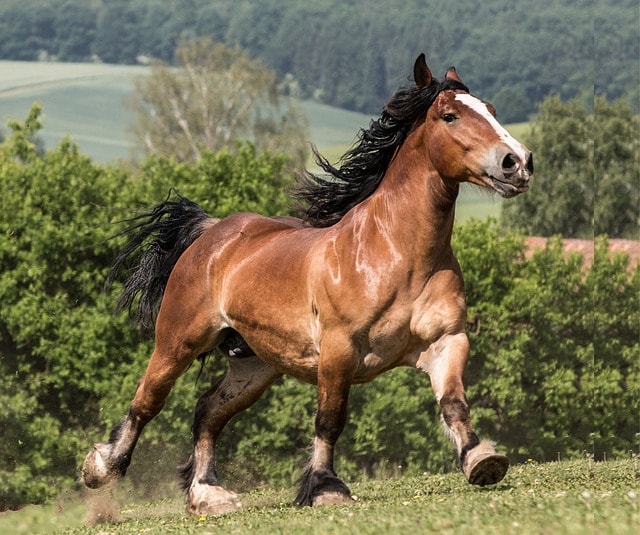Trimming hooves on horses is vital for preventing infections, pain, and movement issues. This guide covers the steps, tools, and techniques needed to trim your horse’s hooves properly. Learn how to maintain your horse’s hoof health effectively.
Key Takeaways
-
Regular hoof trimming is essential for a horse’s health and is horse grooming 101. It will help prevent discomfort, movement issues, and severe health complications.
-
Understanding hoof anatomy and using proper tools are crucial for effective trimming and maintaining hoof health.
-
Seasonal hoof care should be adjusted based on growth rates, with specific care strategies for summer and winter to ensure optimal hoof health.
Importance of Regular Hoof Trimming

Regular hoof trimming is vital for your horse’s overall health and well-being. Failing to trim hooves can cause numerous problems, including severe discomfort and movement issues due to long and curled hooves. In extreme cases, neglecting hoof care can lead to such severe health issues that euthanasia might be the only humane option.
A consistent hoof-trimming schedule prevents foot distortion and reduces the risk of injuries and infections. Balanced hooves enhance movement and reduce stress on bones, tendons, and ligaments. Properly trimmed hooves ensure comfortable movement and promote overall leg and hoof soundness. Regular trimming also helps horse owners spot and address minor issues before they become serious problems.
The main goal of trimming a horse’s hoof is to achieve good hoof balance, which improves movement and reduces body stress. Regular hoof care ensures horses lead healthy, active lives without the discomfort and pain of neglected hooves.
Understanding the Anatomy of a Horse’s Hoof

Understanding the anatomy of a horse’s hoof is key to effective trimming and care. The hoof consists of several parts: the wall, hoof sole, frog, and bars, each playing a crucial role in the horse’s hoof functionality and health.
The hoof wall, visible when the horse stands, covers the sides and front of the coffin bone, providing stability and support. It grows continuously, about three-eighths of an inch each month. Despite its toughness, the hoof wall lacks blood vessels and nerves, so trimming it doesn’t cause pain to the horse.
The frog, a V-shaped structure, is essential for the hoof. It functions as a blood pump, aiding circulation, and acts as a shock absorber, being the first part to contact the ground. Knowing these components and their functions helps maintain a healthy hoof and ensure proper trimming.
Tools Needed for Hoof Trimming

Effective hoof trimming requires proper tools, including hoof nippers, a hoof knife, and a hoof rasp. Each tool serves a specific purpose in achieving a well-trimmed hoof.
Hoof nippers remove excess hoof material quickly before final trimming. The hoof knife cleans and delicately shapes the hoof, ensuring no harmful debris remains. Finally, the hoof rasp shapes and smoothes the hoof wall, giving it a neat finish.
These tools ensure each hoof is properly maintained, contributing to overall hoof health.
Step-by-Step Guide to Trimming Hooves

Trimming a horse’s hooves requires patience and precision. A methodical approach ensures the entire hoof is cared for, preventing future health issues. A hoof stand can be helpful, providing support and preventing back strain during horse hoof trimming and horse hooves trimming.
Wearing an apron or chaps enhances safety and convenience by providing pockets for tools.
The next sections guide you through preparing the horse, trimming the hoof wall, and maintaining the frog and sole, covering all steps to achieve a healthy hoof.

Preparing the Horse
Begin hoof trimming by preparing the horse properly. Start by thoroughly cleaning the hoof to remove dirt or debris. A brush or wire brush can help get rid of dust, ensuring the hoof is clean before trimming.
Proper positioning is crucial. The horse’s hoof should face you during trimming for proper technique. Holding the hoof between your knees can stabilize it, making the process safer and more effective.
Foals should have their first hoof trim at one to two weeks of age to prevent permanent deviations in hoof and leg structure.
Trimming the Hoof Wall
Trimming the hoof wall is crucial for hoof health. Start by using nippers to remove excess hoof wall material. Maintain the correct length of both the toe and the heel. Trim the front of the hoof at a 45-degree angle to prevent a sharp toe.
The white line, where the hoof wall meets the sole, guides filing to smooth sharp edges left by the nippers. Ensuring the hoof wall is even is crucial for balance. If one heel height is higher, file down the higher heel to match the lower one.
Understanding the hoof’s structure and maintaining stability is vital before trimming.
Maintaining the Frog and Sole
Maintaining the frog and sole is as important as trimming the hoof wall. The frog acts as a shock absorber and is the first part to contact the ground. The cushion, under the frog, aids blood circulation within the hoof. Along with the bars of the hoof wall, these structures bear weight and contribute to overall hoof health.
When trimming the frog, avoid removing too much material. Over-trimming can cause serious health issues. If unsure about removing part of the sole, only exfoliate it if it chips or flakes easily.
Study the appearance of a healthy frog to decide when and how much to trim. If you notice any injuries or abnormalities, consult a veterinarian immediately for proper treatment.
Common Hoof Problems and Their Solutions

Despite regular hoof care, horses can still face common hoof problems such as thrush, white line disease, and seedy toe, each requiring specific treatments. Awareness and knowledge of how to address these issues are crucial for maintaining hoof health.
Thrush is a common infection caused by bacteria in damp environments and can lead to lameness if untreated. White line disease involves bacteria and fungi invading the hoof wall, causing significant damage. Seedy toe, often linked to white line disease, is characterized by hoof wall separation due to infection.
The next sections will delve into each of these conditions in detail.
Thrush
A foul-smelling black oozy liquid around the frog indicates thrush. Wet and soiled conditions are ideal for thrush development. Symptoms include pain and lameness, making prompt treatment essential. Keeping stalls or barns clean and dry prevents bacteria from thriving.
Copper Frog Alloy Inserts from Kawell USA prevent bacterial and fungal infections, enhancing hoof health. These inserts kill bacteria and fungi on contact, preventing microorganisms from proliferating in the frog.
White Line Disease
White line disease is a serious condition caused by bacteria and fungi invading the hoof wall, leading to severe damage. It is often linked to seedy toe, where the hoof wall separates due to infection.
Treating white line disease involves removing infected hoof wall material, applying antifungal and antibacterial treatments, and keeping the affected area dry and clean. Regular monitoring and proper hoof care can help prevent the condition from developing.
Seedy Toe
Seedy toe, another common hoof issue, results from poor hoof management. It is characterized by hoof wall separation and discoloration, caused by environmental conditions, improper trimming, and persistent moisture.
Effective treatments include cleaning the affected area, applying antifungal solutions, and consulting a veterinarian for severe cases. Preventative measures like regular trimming and ensuring dry living conditions are crucial for managing seedy toe.

Seasonal Hoof Care Considerations
Hoof care should be adjusted according to the seasons to ensure optimal hoof health. The frequency of hoof trimming can vary based on the horse and the time of year. Some horses may require trimming every four weeks, while others can go longer. Understanding these seasonal variations is essential for maintaining healthy hooves year-round.
During colder months, hoof growth tends to slow down, which may reduce the need for frequent trimming. Conversely, the warmer summer months often see faster hoof growth, requiring more frequent trimming.
The next sections provide specific tips for summer and winter hoof care.
Summer Hoof Care
In the summer, trim hooves every 6 to 8 weeks to maintain optimal health. Show horses may require more frequent trimming to ensure they look their best. The increased growth rate during summer necessitates vigilant hoof care to prevent overgrowth and associated issues.
Keeping hooves clean and dry, despite potentially wetter summer conditions, is important. Regular inspections help catch developing issues early, allowing for prompt treatment.
Winter Hoof Care
In winter, trim or shoe hooves every 6 to 12 weeks to accommodate slower growth rates and varying ground conditions. Cold weather typically slows hoof growth, reducing the need for frequent trimming.
However, winter conditions also bring challenges such as ice and snow, impacting hoof health. Proper hoof care during these months ensures the horse remains comfortable and healthy, even in harsh weather.

Enhancing Hoof Health Through Nutrition
Proper nutrition significantly influences hoof growth and quality. Deficiencies in essential nutrients like amino acids (methionine and cystine) can lead to softer, crack-prone hooves. Vitamins A and E are crucial for hoof health, and their deficiencies can result in poor growth and inflammation. Minerals like zinc and copper are also essential for supporting hoof growth.
Maintaining moisture levels in the hooves is critical, especially during hot, dry summer months. Kawell USA’s Horse Hoof Paste nourishes and protects hooves from environmental damage, promoting strength and durability. Additionally, using hoof moisturizers can further enhance hoof health.
Using high-quality hoof care products, such as those offered by Kawell USA, can enhance hoof health and prevent common hoof issues. These products are designed to improve the structural integrity of the hoof and support its natural healing processes.

Kawell USA Products for Hoof Care
Kawell USA is dedicated to providing innovative solutions for hoof care. By incorporating high-quality products into your horse’s hoof care routine, you can significantly enhance the health and performance of your horse’s hooves. Their range of products, including Copper Alloy Horseshoes, Horse Hoof Paste, and Copper Frog Alloy Inserts, are designed to protect and nourish hooves.
These products offer various benefits, from antimicrobial properties to improved hoof durability, making them an excellent choice for maintaining hoof health. Using Kawell USA products can lead to stronger, healthier hooves and a lower incidence of common hoof issues.
These products are crafted with the well-being of horses in mind, ensuring that every step your horse takes is supported by superior hoof capsule care solutions.

Copper Alloy Horseshoes
Kawell USA’s Copper Alloy Horseshoes provide enhanced durability and protection compared to traditional materials. These horseshoes offer antimicrobial properties that eliminate 99% of bacteria and fungi, aiding in the prevention and treatment of seedy toe, white line disease, and thrush. This makes them an excellent choice for maintaining a healthy hoof environment.
Additionally, these horseshoes provide high-impact absorption of 8.53% with every step, offering unparalleled support for the horse’s comfort. Made from 100% recyclable material, Kawell USA Copper Alloy Horseshoes also align with eco-friendly practices, making them a sustainable choice for conscientious horse owners.

Horse Hoof Paste
Kawell USA Horse Hoof Paste is crafted with natural ingredients to nourish, strengthen, and protect the horse’s hooves. This paste penetrates the hoof structure, providing essential nutrients that promote overall hoof integrity and strength. The natural formulation ensures that the hooves remain moisturized, preventing dryness and cracking, which are common issues during the hot, dry summer months.
The protective benefits of the paste help guard against environmental stressors and potential hoof issues, supporting healthy hoof growth and aiding in the natural healing of minor cracks. Using this paste regularly can significantly improve the health and durability of your horse’s hooves.

Copper Frog Alloy Inserts
Kawell USA Copper Frog Alloy Inserts are designed to kill bacteria and fungi on contact, preventing the proliferation of microorganisms in the frogs of a hoof. This is crucial for maintaining a healthy frog, which plays a vital role in shock absorption and blood circulation within the hoof.
By using these inserts, horse owners can enhance their horse’s overall hoof health and resilience against infections. Preventing bacterial and fungal infections is essential to avoid lameness and other serious hoof issues.
Incorporating Copper Frog Alloy Inserts into your hoof care routine ensures that your horse’s hooves remain healthy and strong.

Summary
In summary, regular hoof trimming is essential for maintaining the health and well-being of your horse. Understanding the anatomy of a horse’s hoof, using the right tools, and following a step-by-step trimming process can help ensure that your horse’s hooves remain in top condition. Addressing common hoof problems promptly and adjusting hoof care practices according to seasonal needs are also crucial for preventing serious health issues.
Enhancing hoof health through proper nutrition and using high-quality products like those from Kawell USA can further support your horse’s hoof care routine. By implementing these best practices, you can ensure that your horse enjoys a lifetime of sound, healthy hooves. Remember, a healthy hoof is the foundation of a healthy horse.
Frequently Asked Questions
How often should I trim my horse's hooves?
To maintain your horse's hoof health, trim them every 6 to 8 weeks. Regular trimming helps prevent issues and ensures optimal growth.
What are the signs of thrush in a horse's hoof?
The primary signs of thrush in a horse's hoof are a foul-smelling black discharge around the frog and lameness. If you notice these symptoms, it’s important to seek veterinary attention promptly.
What is the role of the hoof frog?
The hoof frog plays a crucial role as a shock absorber and helps facilitate blood circulation within the hoof. This function is essential for the overall health and comfort of the horse.
How can I prevent white line disease?
To effectively prevent white line disease, prioritize regular hoof care, maintain dry living conditions, and consider using antimicrobial products such as Kawell USA Copper Alloy Horseshoes. These measures will significantly reduce the risk of this condition.
What nutrients are essential for hoof health?
To maintain optimal hoof health, it's crucial to ensure adequate intake of amino acids like methionine and cystine, as well as vitamins A and E, zinc, and copper. These nutrients play a vital role in supporting strong and resilient hooves.










